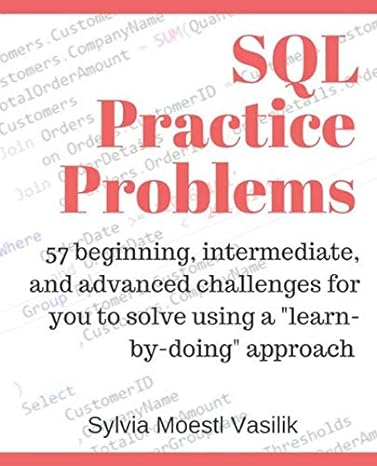Question
(C++) Finding the Maximum Recursively [Tail Method] For this part of the lab activity, implement a recursive function that will find the maximum element in
(C++)
Finding the Maximum Recursively [Tail Method]
For this part of the lab activity, implement a recursive function that will find the maximum element in an array using the tail method discussed in lecture. This function should be generic, like the other versions from the lecture. Make sure to also conduct an asymptotic analysis for your implementation based on the number of comparison and arithmetic operations. Then, write some test cases in main to validate your implementation.
Tower of Hanoi
For the second part of the lab activity, implement a recursive function to solve the Tower of Hanoi problem. Use the following function prototype:
void towerHanoi(int, string, string, string, int&);
The first parameter is the number of disks. The second parameter is the source rod. The third parameter is the buffer rod. The fourth parameter is the target rod. The fifth parameter is the total number of moves made.
Your implementation should display a message when it "moves" a disk from the source rod to the target rod. It should be in the format:
Moving disc i from rod #x to rod #y
Make sure to also provide an asymptotic analysis based on the number of "moves".
Sample Run
The following is an example of what your program can display:
**************************************** Trying n = 1 Moving disc 1 from Rod #1 to Rod #3 Number of Moves = 1 **************************************** Trying n = 2 Moving disc 1 from Rod #1 to Rod #2 Moving disc 2 from Rod #1 to Rod #3 Moving disc 1 from Rod #2 to Rod #3 Number of Moves = 3 **************************************** Trying n = 3 Moving disc 1 from Rod #1 to Rod #3 Moving disc 2 from Rod #1 to Rod #2 Moving disc 1 from Rod #3 to Rod #2 Moving disc 3 from Rod #1 to Rod #3 Moving disc 1 from Rod #2 to Rod #1 Moving disc 2 from Rod #2 to Rod #3 Moving disc 1 from Rod #1 to Rod #3 Number of Moves = 7 **************************************** Trying n = 4 Moving disc 1 from Rod #1 to Rod #2 Moving disc 2 from Rod #1 to Rod #3 Moving disc 1 from Rod #2 to Rod #3 Moving disc 3 from Rod #1 to Rod #2 Moving disc 1 from Rod #3 to Rod #1 Moving disc 2 from Rod #3 to Rod #2 Moving disc 1 from Rod #1 to Rod #2 Moving disc 4 from Rod #1 to Rod #3 Moving disc 1 from Rod #2 to Rod #3 Moving disc 2 from Rod #2 to Rod #1 Moving disc 1 from Rod #3 to Rod #1 Moving disc 3 from Rod #2 to Rod #3 Moving disc 1 from Rod #1 to Rod #2 Moving disc 2 from Rod #1 to Rod #3 Moving disc 1 from Rod #2 to Rod #3 Number of Moves = 15
Step by Step Solution
There are 3 Steps involved in it
Step: 1

Get Instant Access to Expert-Tailored Solutions
See step-by-step solutions with expert insights and AI powered tools for academic success
Step: 2

Step: 3

Ace Your Homework with AI
Get the answers you need in no time with our AI-driven, step-by-step assistance
Get Started


